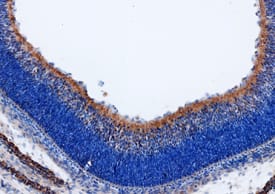Mouse Wnt-9b Antibody
R&D Systems, part of Bio-Techne | Catalog # AF3669


Key Product Details
Species Reactivity
Validated:
Cited:
Applications
Validated:
Cited:
Label
Antibody Source
Product Specifications
Immunogen
Ala46-Glu90, Lys228-Tyr298
Accession # O35468
Specificity
Clonality
Host
Isotype
Scientific Data Images for Mouse Wnt-9b Antibody
Wnt‑9b in Mouse Embryo.
Wnt-9b was detected in imm-ersion fixed frozen sections of mouse embryo (13 d.p.c.) using Goat Anti-Mouse Wnt-9b Antigen Affinity-purified Poly-clonal Antibody (Catalog # AF3669) at 15 µg/mL overnight at 4 °C. Tissue was stained using the Anti-Goat HRP-DAB Cell & Tissue Staining Kit (brown; Catalog # CTS008) and counter-stained with hematoxylin (blue). Specific staining was localized to the retina. View our protocol for Chromogenic IHC Staining of Frozen Tissue Sections.Applications for Mouse Wnt-9b Antibody
Immunohistochemistry
Sample: Immersion fixed frozen sections of mouse embryo (E13 d.p.c.)
Western Blot
Sample: Recombinant Mouse Wnt-9b (Catalog # 3669-WN)
Formulation, Preparation, and Storage
Purification
Reconstitution
Formulation
Shipping
Stability & Storage
- 12 months from date of receipt, -20 to -70 °C as supplied.
- 1 month, 2 to 8 °C under sterile conditions after reconstitution.
- 6 months, -20 to -70 °C under sterile conditions after reconstitution.
Background: Wnt-9b
Mouse Wnt-9b, previously called Wnt-14b or Wnt-15, is one of about 19 vertebrate members of the Wingless-type MMTV integration site (Wnt) family of highly conserved, cysteine-rich secreted glycoproteins important for normal developmental processes (1‑3). Wnts mainly transduce signals by binding to receptors of the Frizzled family, in conjunction with a coreceptor of the low-density lipoprotein receptor-related protein family (LRP-5 or -6) (1, 2). The 359 aa mouse Wnt-9b precursor contains a 336 aa mature region with 24 conserved cysteines (3). Mature mouse Wnt-9b shares 93%, 98%, 92%, 92% and 91% aa identity with human, rat, canine, equine and bovine Wnt-9b, respectively. It is evolutionarily related to Wnt-9a and Wnt-3, which share 63% and 32% aa identity, respectively (4). Wnt-9b mRNA is expressed in late embryos and in adult kidney, with lesser amounts in brain and liver (3, 4). It appears to direct mesenchymal-to-epithelial transition in the kidney and other tissues (5). During kidney development, it is expressed in the ureteric bud and induces mesonephric and metanephric tubulogenesis, nephron development, and caudal extension of the Mullerian duct, acting upstream of Wnt-4 (5‑7). Induction is dependent on beta-catenin activity, implicating the canonical signaling pathway (7). Mice devoid of Wnt-9b die shortly after birth due to kidney agenesis, while low expression results in small kidneys with fewer nephrons (1, 5, 6). Mutations of Wnt-9b also cause incompletely penetrant cleft lip and palate in mice, indicating its involvement with facial midline morphogenesis (8, 9). It has weak transforming activity compared to other transforming Wnts (4).
References
- http://www.stanford.edu/group/nusselab/cgi-bin/wnt/.
- Logan, C. Y. and R. Nusse (2004) Annu. Rev. Cell Dev. Biol. 20:781.
- Kirikoshi, H. and M. Katoh (2002) Int. J. Mol. Med. 9:135.
- Qian, J. et al. (2003) Genomics 81:34.
- Carroll, T. J. et al. (2005) Dev. Cell 9:283.
- Merkel, C. E. et al. (2007) Pediatr. Nephrol. 22:1825.
- Park, J-S. et al. (2007) Development 134:2533.
- Lan, Y. et al. (2006) Dev. Dyn. 235:1448.
- Juriloff, D. M. and M. J. Harris (2008) Birth Defects Res. A Clin. Mol. Teratol. 82:63.
Long Name
Alternate Names
Gene Symbol
UniProt
Additional Wnt-9b Products
Product Documents for Mouse Wnt-9b Antibody
Product Specific Notices for Mouse Wnt-9b Antibody
For research use only